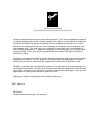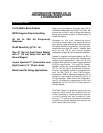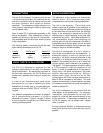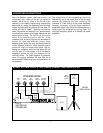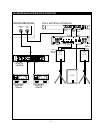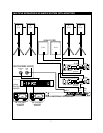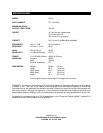
The two 4-Pole Speakon
™
connectors and the two
1/4" phone jacks are wired in full parallel so that any
one of the connectors may be used as an input and
the other connector as an output to another
subwoofer. This allows the multiple cabinets to be
"daisy chained", eliminating the need for several long
runs of speaker cable.
Note: A single CS-18 subwoofer represents an 8Ω
load to the amplifier. Daisy chaining two of them in
parallel will represent a 4Ω load to the amplifier.
Only amplifiers rated for 4Ω output should be used
in this configuration.
The following polarity convention should be used
when making connections to the CS-18:
Polarity Phone Jack Speakon™
Positive (+) Tip 1+ and/or 2+
Negative (-) Sleeve 1- and/or 2-
The CS-18 is designed to augment the low
frequency performance of the main P.A. speakers
using bi-amplification. By reproducing high levels of
the low bass frequencies, the CS-18 relieves the
smaller main speakers from having to supply this
energy.
In order to split frequencies and send certain
frequencies to one type of speaker and other
frequencies to another type, a line-level electronic
crossover, such as a Fender
®
PCN-2
™
or PCN-4
™
, is
required.
Two different configurations are shown on pages 5
and 6, demonstrating how easy it is to add a
subwoofer to a system. Figure 3, on page 7, shows
a more extensive configuration for those set-ups
requiring additional power.
The placement of any speaker can dramatically
affect its sound. Thus, there are three primary
considerations to review when placing subwoofers.
The first is time alignment. The mid/high racks
should be as close as possible to the subwoofer so
the sound from the subwoofer reaches the audience
at the same time as the sound from the mid/high
packs. If the subwoofer is placed too far from the
mid/high packs, a slight smearing of the lower bass
frequencies may occur. While ideal placement for
this consideration would involve stacking the
mid/high pack on top of the subwoofer, this effect is
quite subtle and an obvious effect may not be heard
until the separation between the two cabinets is large
enough to cause an audible time delay.
The second consideration is to try to obtain as
much bass as possible from the subwoofer. A
subwoofer hanging in free air is referred to as
operating in "full space" since the subwoofer is free
to radiate in all directions (omnidirectionally). A
speaker in the middle of the floor or up in the air with
its back against a wall is referred to as operating in
"half space". Full space operation will result in about
a 3 dB decrease in output as compared to half
space. In order to compensate for the decrease in
output using a full space configuration, the power
amplifier may need to be turned up. Placing a
speaker near a large, flat wall and on the floor
(quarter space) will boost the bass performance by
about 3 dB as compared to half space. The more
surfaces the subwoofer is placed against, the fewer
the number of subwoofer enclosures are needed to
achieve a desired SPL.
The third consideration is convenience and the
visual aspect of the speaker array. For temporary
installations, the subwoofer can be used as a
support for a mid/high pack mounted directly on top
of the subwoofer. In permanent installations, the
CS-18, for example, can be placed under a stage,
table, or podium.
For each particular situation, a compromise among
these three factors should yield the best solution
possible.
CONNECTIONS
USING THE CS-18 IN A SYSTEM
SETUP SUGGESTIONS
4




